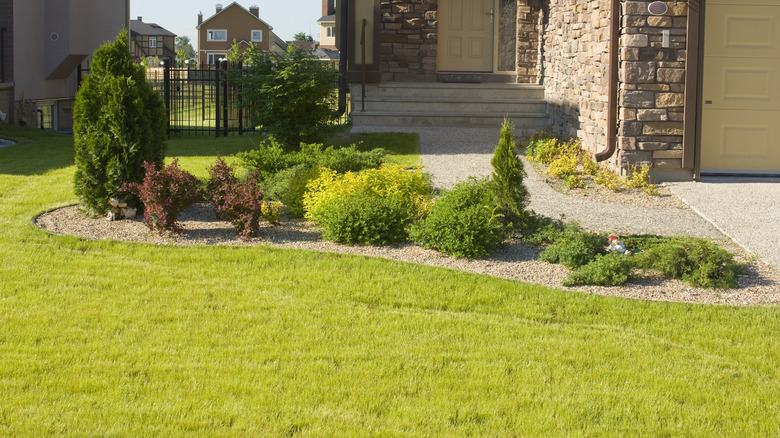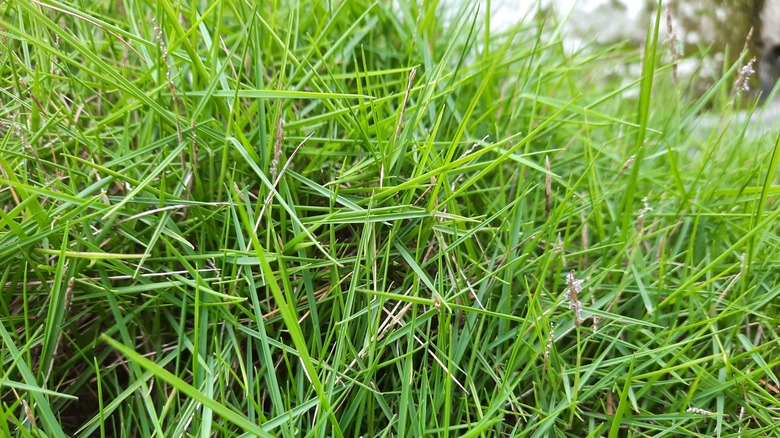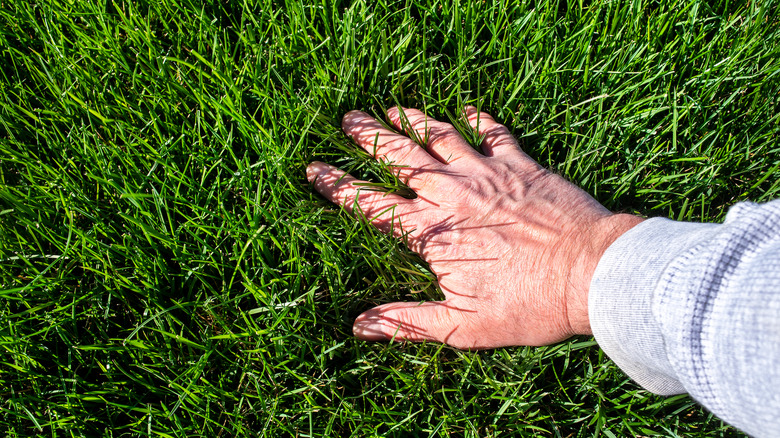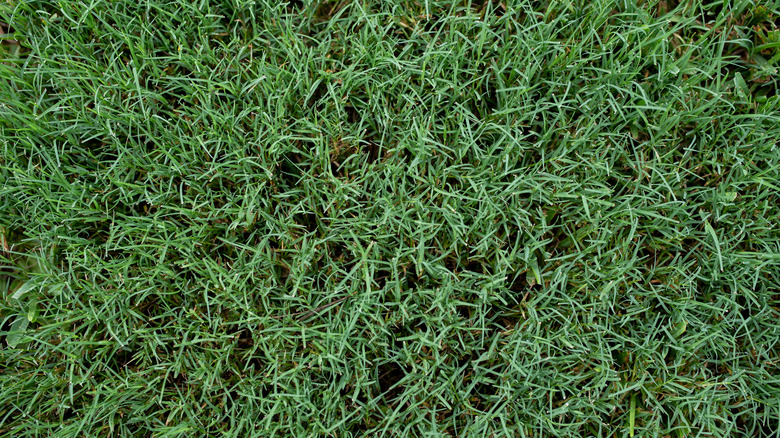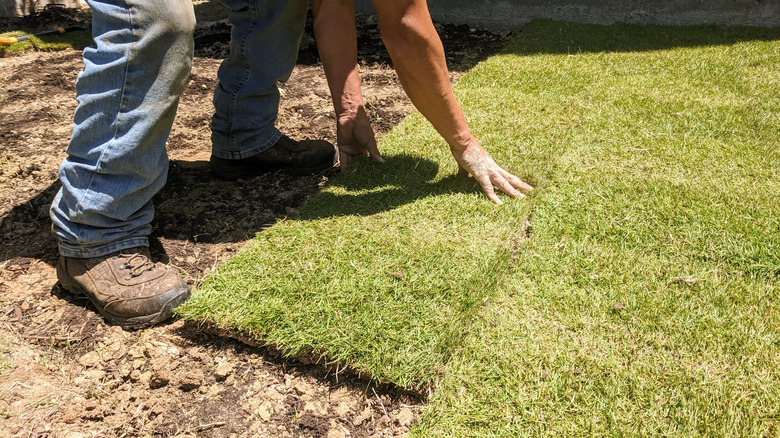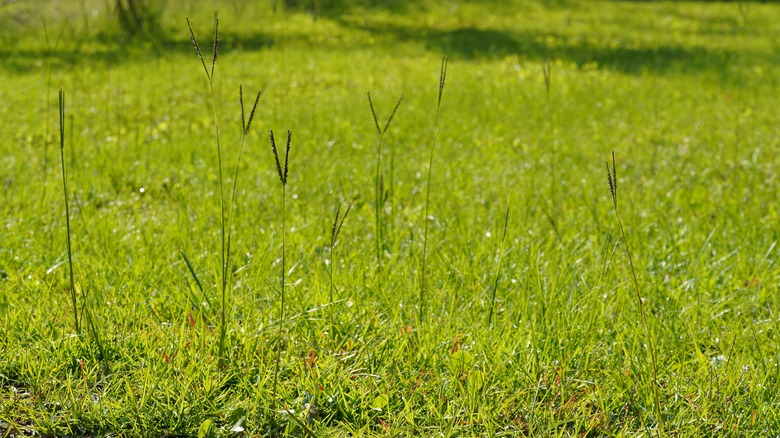5 Grasses That Love Life In Well-Draining, Sandy Soil
If you live in a region of the United States that has sandy soil, you know first-hand how frustrating it can be to try and keep a healthy lawn. We all want bright green grass in our yards, as this addition makes our outdoor oases that much more enjoyable. However, the coarse soil that can be found in states like Florida, Nebraska, Michigan, Texas, Georgia, Wisconsin, and Minnesota (among others) makes for harsh growing conditions. Fortunately, despite the common notion that grass needs nutrient-packed soil to grow full and healthy, there are plenty of varieties that can prosper in sandy, well-draining conditions and withstand droughts and other challenges.
Some grasses can indeed grow in sandy soil, with bentgrass, tall fescue, bermudagrass, zoysia, and bahiagrass being just five types of hardy turfs that could be the answer to all your lawn qualms. While all of these grasses have different care needs and will adapt better or worse to certain climates, each one presents a resilient front and a love for well-draining, sandy soils. Discover which option is the best choice for your area and specific needs.
Bentgrass (Agrostis)
Bentgrass is incredibly popular for its ability to thrive in sandy and well-draining locations. This cool-season grass prefers an acidic pH level of soil that's between 5 and 6.5 and can be grown in many different climates. Bentgrass planted in hotter regions will need more care than in colder areas, as it will require more frequent watering, mowing, pest treatments, and fertilization. Because of this, it's best to plant this type in northern regions that receive cooler weather, where it will mostly require just watering and mowing. Best grown in fall or spring, bentgrass has a vibrant green color with a smooth and refined look.
The three most common types of bentgrass include creeping, colonial, and velvet. Creeping is quite common for golf courses but is not as tolerant of excessive heat or cold. Colonial is the tallest among the three and more often grown on home lawns in Northern California and other coastal areas within the state. While velvet is less-commonly used, it can be applied in various places and has the most delicate and fine texture. Regardless of which type of bentgrass one chooses, it will need persistent care and attention.
Tall fescue (Festuca arundinacea)
Tall fescue is another cool-season grass that does well in highly-aerated soils and can be grown in an acidic to neutral pH levels of about 5.5 to 7. This grass was solely used in pastures until the late 1900s before becoming a staple in home lawns. It is adaptive to more than just sandy and rocky climates, as its deep root system makes it durable in different conditions. Tall fescue is a slow grower, but in the peak seasons of spring and fall, you'll see it grow more rapidly. It is sought after due to its resistance to extreme cold and hot temperatures, drought, disease, and heavy foot traffic. This type is a good choice if your yard sees lots of activity, especially from children and pets.
As a bunch-type grass, tall fescue grows in clusters, so while it is quite hardy, it may not look as full as you desire. Kentucky 31 is a widespread variety of tall fescue, with spring and fall being the best times for planting in ideal temperatures of 50 to 65 degrees Fahrenheit. Full to partial sun and shade is best, and keep the blades at about 2 to 3 inches tall. Also provide your lawn with about an inch of water applied each week, depending on the weather. When grown strong and healthy, you can expect to see a darker coloration with broad blades and a rough texture.
Bermudagrass (Cynodon dactylon)
Bermudagrass is a warm-season type that prefers full sun. It grows well in coarse, well-draining soils and prefers a mildly acidic to neutral pH level of 5.8 to 7. Spring and summer are this grasses peak times of the year, making this a great type for coastal homes and other incredibly-sunny regions that see high heat throughout the warmer months. While bermudagrass can tolerate colder climates, it is not nearly as receptive to it as it is to hotter weather. It is fast-growing compared to other warm-season grasses, which means it requires higher maintenance, as it needs more fertilizer as well as frequent waterings and biweekly mowings.
Riviera and yukon bermudagrass are two go-to varieties that are known to be resistant to both drought and salt. Overall, bermudagrasses bounce back quickly from damage and perform well in higher-traffic areas. It's best to plant this type in the spring, or in temperatures of 65 to 70 degrees Fahrenheit. An average inch of water each week and keeping the blades about 1 to 2 inches tall is ideal for a thriving yard of bermudagrass.
Zoysia (Zoysia japonica)
As a warm-season perennial grass, zoysia flourishes in well-draining soil that maintains a pH level of 6 to 6.5. It does not do well in shaded locations, as it requires full sun to grow properly. Its deep root system makes it a perfect addition to sandy and course environments such as beaches, and its ability to hold excess water and nutrients makes it drought-tolerant. Zoysia is a slow grower, but it is also a dense and plush grass that does well against foot traffic, making it ideal for parks, golf courses, recreational areas, and yards that are used frequently.
Unlike bermudagrass, zoysia is low maintenance and more hands-off. It peaks in the hottest summer months at 80 degrees Fahrenheit or higher. Thus, it is best grown in southern areas of the United States but can still be produced in slightly-colder climates as long as extra care is provided to aid in its growth. Zoysia japonic, also called meyer, and zoysia matrella are two frequently-planted varieties for home lawns. To make your lawn thrive, this grass requires about an inch of water each week, though it can grow with less water as well.
Bahiagrass (Paspalum notatum)
As another warm-season grass, bahiagrass thrives in total sun exposure and highly-aerated soil, preferring a pH level of 5.5 to 6.5. Its deep roots make sandy and coarse locations more favorable, but it can handle some shade and poor-draining soils as well. Bahiagrass is very resistant to heat and drought, meaning that it needs much less water to grow than many other grasses. However, because of this, it's quite easy to overwater because it needs such little irrigation. Overall, this type has very low care requirements and can thrive in a variety of hot climates.
Bahiagrass does not grow as thick and full as other grasses, but it will survive some of the toughest weather conditions. It is most commonly grown in the southeast region of the United States. Though it's slow to germinate, it's strong and hardy. Pensacola bahiagrass is the most widely-grown variety, and one should plan to plant it in early spring for the best results. If you live in a warm climate and are looking for a hands-off grass that will withstand harsh environments, bahiagrass may be an excellent choice for your lawn.

